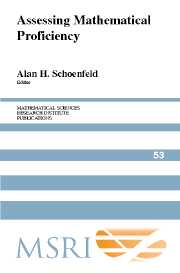Book contents
- Frontmatter
- Contents
- Preface
- Acknowledgments
- Section 1 The Big Picture
- Section 2 Perspectives on Mathematical Proficiency
- Section 3 What Does Assessment Assess? Issues and Examples
- Section 4 The Case of Algebra
- 11 Assessing the Strands of Student Proficiency in Elementary Algebra
- 12 Making Meaning in Algebra: Examining Students' Understandings and Misconceptions
- 13 Task Context and Assessment
- Section 5 What Do Assessments Assess? The Case of Fractions
- Section 6 The Importance of Societal Context
- Epilogue: What Do We Need to Know? Items for a Research Agenda
- About the Authors
- Subject Index
- Author Index
- Task Index
12 - Making Meaning in Algebra: Examining Students' Understandings and Misconceptions
Published online by Cambridge University Press: 06 July 2010
- Frontmatter
- Contents
- Preface
- Acknowledgments
- Section 1 The Big Picture
- Section 2 Perspectives on Mathematical Proficiency
- Section 3 What Does Assessment Assess? Issues and Examples
- Section 4 The Case of Algebra
- 11 Assessing the Strands of Student Proficiency in Elementary Algebra
- 12 Making Meaning in Algebra: Examining Students' Understandings and Misconceptions
- 13 Task Context and Assessment
- Section 5 What Do Assessments Assess? The Case of Fractions
- Section 6 The Importance of Societal Context
- Epilogue: What Do We Need to Know? Items for a Research Agenda
- About the Authors
- Subject Index
- Author Index
- Task Index
Summary
Students often get confused and lost when they take Algebra 1. The underpinning of the course is the generalization of the arithmetic they have previously studied and communication about mathematical ideas in a language that is rich in symbolic notation. Therefore it is not surprising for students to find algebra as abstract and unconnected to the real world.
Over the past twenty years, there has been a movement in the United States to make algebra more concrete. Specialized manipulatives have been invented in order to provide “hands-on” materials for students to use. Algebra tiles, positive and negative counters, and balance apparatuses, to name a few, are commercially available materials for “concrete learning” of algebra.
Although concrete materials may be helpful for students to learn algebra, it is not the materials themselves that provide algebraic meaning or understanding. Some educators assume that from the use of hands-on materials, students will automatically jump to abstract understanding of algebra. Research informs us that this is not the case. Physical knowledge is knowledge of objects observable in external reality, while mathematical knowledge is the mental relationships students construct in their heads. The source of mathematical knowledge is thus in the student [Kamii and DeClark 1985].
It is equally true that if students are taught abstract ideas without meaning, there will be no understanding. Students need experiences with a concept to develop meaning for themselves.
- Type
- Chapter
- Information
- Assessing Mathematical Proficiency , pp. 163 - 176Publisher: Cambridge University PressPrint publication year: 2007
- 8
- Cited by

